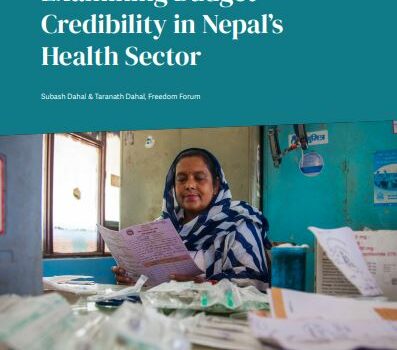Nepal underspends its approved budget annually, and in recent years, the country’s aggregate budget has seen repeated downward revisions. The lack of parliamentary budget approval makes matters worse by enabling the poor institutional practice of shifting approved funds from one budget category to another. Consequently, key social sector ministries– including Environment, Agriculture and Food, and Health underspent their budgets by an average of 4, 30, and 35 percent, respectively, during budget implementation between 2018 and 2020.
Nepal’s 2020 Voluntary National Review on the Sustainable Development Goals (SDGs) notes that despite the modest gains to “ensure healthy lives and promote well-being for all at all ages” (SDG 3), there are still critical challenges plaguing Nepal’s health sector that must be addressed. The key difficulty is ensuring access to health services for every citizen of Nepal, especially those in poor and marginalized communities. A health insurance scheme is being implemented in partnership with the federal government to decrease the out-of-pocket expenditure of local people. However, there is a long way to go, as data indicates that only seven percent of the population has health insurance. Besides the accessibility problem, the quality of health services requires attention. To aid efforts toward achieving SDG 3, Nepal should improve the execution of its health budget, implementing it as approved.
The Nepal Government health expenditure as a percentage of the GDP was static until FY 2017/18, when it reached 1.5 percent and 2.2 percent and 2.4 percent in FY 2019/20 and FY 2020/21 respectively. The World Health Organization reports that public expenditure of almost 6% of GDP on health will considerably reduce out-of-pocket payments for healthcare services. Therefore, public health expenditure above 5% of GDP is necessary to attain a conservative target of 90% coverage of maternal and child health services and progress towards universal Health Coverage (UHC). By this measure, the government of Nepal’s outlays on health may be sub-par and not drive efforts towards UHC.
This brief compares actual expenditures against approved budget allocations in Nepal’s health sector, examining why there are significant deviations over the four-year period from FY 2017/18 to FY 2020/21. The brief further analyzes how these budget deviations affect the delivery of planned programs and services within the health sector and recommends reforms to improve the implementation of Nepal’s health budget. To arrive at these recommendations, the authors relied on document reviews, including budget statements and budget performance reports, as well as budget execution data pulled from the Consolidated Financial Statement of the Financial Comptroller General Office. Data on health sector underspending is then compared to Nepal’s health performance indicators, including progress to achieve relevant SDG targets.
Authors: Taranath Dahal and Subash Dahal
Full report: Examining budget credibility in Nepal’s health sector


